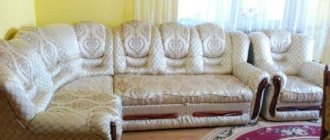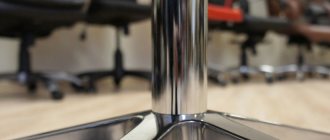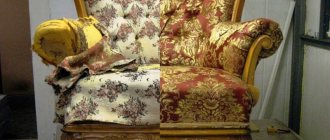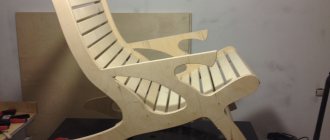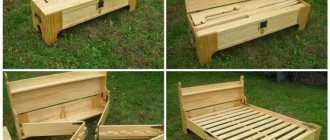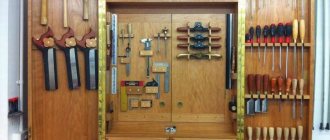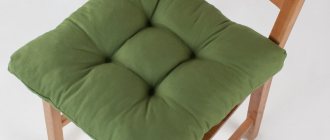Recommendations
To ensure that your computer chair lasts as long as possible, when planning reupholstery, you should choose the right type of material. You should focus on the following parameters:
material possibilities - fabrics can have a wide range of prices, so it is important to understand what you can count on;
interior design - when choosing the color, structure and print of the fabric, you need to take into account the interior of the room in which the furniture is located;
degree of use of the furniture - the choice of material should be made based on how often the chair will be used.
If a computer chair is completely upholstered with material, then it must be replaced everywhere so that the appearance of the product remains presentable. In addition to the seat and back, the armrests, which are also upholstered in fabric, often get very worn, so when purchasing material, it is worth including their dimensions in the size of the future canvas. The upholstery of the armrests is no different from working with other parts of the chair; they are immediately disassembled, then the old materials are replaced with new ones and the finished product is assembled. If the handles have wooden elements, it is recommended to update them by covering them with varnish or stain, which will make the appearance of the finished product more presentable.
To ensure that caring for the chair does not cause great difficulties, it is worth choosing not only durable and strong fabric. In addition, it should repel water and be easy to clean. If there is a question about choosing a color, it is better to buy a plain material, since the presence of a pattern may necessitate the selection of elements, which will increase the consumption of material, and accordingly, the cost and duration of the work.
An equally important point will be the choice of foam rubber, which is located under the upholstery. If its thickness or density is too small, then the comfort from using such a chair will be minimal. The choice of thickness should depend on the type of chair and the weight of the person who will sit on it. To increase the shock-absorbing properties and keep the soft parts of the chair elastic for as long as possible, you can lay a sheet of polyethylene foam on the base, which has greater elasticity and will not sag over time. By placing polyethylene, high-quality foam rubber and upholstery material, you can create a more comfortable computer chair than it was originally, and use it comfortably for a long time.
You can watch a detailed video about reupholstering a computer chair with your own hands below.
Chair renovation ideas
There is no need to throw away old furniture right away. You can easily make a bright interior detail from it without going to a specialized workshop. Before you start redoing an old chair with your own hands, you need to decide on the type of damage, the type of product and prepare the necessary tools and materials. There are several types of operations that you can perform independently:
| Padding. | An operation that involves changing the old fabric, restoring the internal structure of the seat and replacing the filling - foam rubber. The wooden surface of furniture can also be restored. |
| Upholstery. | An operation to restore the appearance of a product by stretching the fabric. Sheathing is often used if the furniture has a rigid structure that is difficult to restore by sanding and painting. This type of repair is also suitable for products with old fabric. By choosing the right fabric, you can get a bright element of the interior. |
| Repair. | This is a generalized concept that combines reupholstery and upholstery, and also includes other procedures for remaking a Soviet chair that improves its condition: restoring the surface by sanding and painting, replacing components, strengthening the structure with metal corners. You can get an original product if you change several parts of the chair. |
Depending on the experience and complexity of the design, these procedures will require from 1 to 4 hours.
Selection of materials
Restoration of kitchen corners requires a careful approach to the choice of material, taking into account operating conditions. Coloring, unusual texture, original design of the canvas are less important than wear resistance and quality. The material is chosen so that you don’t have to reupholster it every year, and the appearance is preserved as long as possible.
| Type of material | Description | pros | Minuses |
| Leather | It is better not to choose genuine leather for self-repair. There is a risk of spoiling the material. It is worth giving preference to artificial. | Durability, spectacular appearance. Wide range of colors, shades, ease of care. | Even artificial leather can be faked, and such material has a much shorter service life. |
| Tapestry | Ideal for frequent use. | Relatively inexpensive material, long service life. Easy to care for using soap solutions. | It becomes unusable after greasy stains appear. Fades with prolonged exposure to direct sunlight. |
| Chenille | Popular material for restoration. | Democratic price. Pleasant to the touch surface. This upholstery is tear-resistant, does not fade, and does not absorb odors. | A wide range is presented only in large cities. In small ones the choice is limited. |
| Flock | Non-absorbent fabric. Suitable for those who decided to upholster furniture themselves for the first time. | The material is resistant to fading and stains. | Short service life: the textured pattern quickly peels off from the surface. |
When choosing material for upholstery, preference should be given to non-marking colors. High-quality fabric is easy to clean; a budget option is more difficult to get rid of stains. It is better to take measurements based on the dimensions of the removed upholstery. If the kitchen is made in the same style, then the material must match in color and texture. The use of contrasting shades for backs and seats is popular. In this case, the corner will become a fashionable accent in the kitchen.
The upholstery of kitchen corners suffers from frequent use, and the fillings lose their elasticity. Sheets of foam rubber are placed inside. In order not to make a mistake with the size, add a centimeter to the measurements on each side.
Leather Tapestry Chenille Flock Foam
Restoration of frame parts
The concept of “restoration” includes not only reupholstery, but also restoration of the wooden parts of the chair. Over time, decorative parts (armrests, turned elements, curly chair legs) become unusable, that is, they become dull, the varnish surface wears off, and small cracks appear on the furniture frame.
What can be done in this case?
To solve this problem we will need:
- Sandpaper,
- Scraper,
- Blade from a stationery knife.
- Varnish, stain.
Every part needs to be sanded. You need to start with coarse grains, gradually moving to smaller ones.
- After the parts have been sanded, carefully remove the dust with a damp cloth or foam sponge.
- Apply nitro varnish with a soft brush until completely dry.
- After the varnish has dried, you can run your hand over the surface and feel how the pile rises. Using the finest sandpaper, we carefully “knock down” the raised fibers, that is, we make the surface smooth.
- Then you can apply a stain (alcohol, water or white spirit based) and only then cover it with any commercially available varnish.
Removing the fabric
Now that all fasteners have been removed, you can begin to remove the main part of the upholstery. The foam or batting underneath may tear during this process. It's okay, because most likely you will need to replace this layer. At the same time, you can make it thicker so that the furniture is softer.
If you see several separate parts in which the filling has lost its properties, it is better to replace the entire filling, while removing the old layer.
There are many original ways to reupholster old chairs and other pieces of furniture. At this point, you need to decide whether you want to stick with the old style of chair, or try something new. The new cut of the upholstery will depend on this. You can sew it yourself, you can go to a studio - the choice is yours.
Next, we install a layer of filler in the form of foam rubber or batting, after which it needs to be secured. Then you just need to go in the opposite direction and then, having reached the bottom, fasten the new upholstery, install the bottom and legs. This completes the re-upholstery.
Frame repair
In some cases, the frame of the sofa also requires repairs, since it is assembled from solid wood and fiberboard. Therefore, all missing parts must be replaced with the same ones, made from well-dried wood that does not have knots.
If the wood is damp, then over time it will dry out and the sofa will break again; the presence of knots can also lead to the sofa breaking.
Fiberboard lintels are the most susceptible to wear, so they will almost certainly have to be replaced. Since the fiberboard sheet is a rather soft material, it can be attached to the frame using both small nails and paper clips, using a pneumatic stapler.
Removing and disassembling seats
To reupholster the seats, you must first dismantle them, remove them from the interior to the workplace, disassemble them and remove the old upholstery. Each car interior has its own characteristics. Therefore, it is impossible to create one instruction that is universally suitable for all seats. Let's look at the main points that are similar for most cars.
Most front seats are fairly easy to remove from the interior. The front seats slide on the tracks (slides). They are bolted to the floor at the front and back. Typically, the places where the slide is attached to the floor are covered with plastic covers. To get to the bolts, you need to move the chair to its extreme position (forward or backward, in turn).
Front seat mounting
- Before removing the seats, you must disconnect all electrical wiring plugs at the bottom. If the seats have side airbags, you need to disconnect the battery and wait 3 minutes before disconnecting the connectors at the bottom of the seats.
- Carefully remove the seat from the interior, do not scratch the plastic trim of the interior with the slide. You can wrap the sharp corners of the seat slide with rags before dismantling. This will protect the interior from accidental scratches. The second front seat is removed in a similar way.
- To remove the rear seat, you usually need to first remove the lower part of the seat. There are two different methods that are used to secure the bottom of the rear seat. These are two bolts or two latches on the front that secure the seat to the floor. You need to unscrew or snap off the bottom of the seat and pull it out. After removing the lower part, the bolts securing the rear seat back become visible. After unscrewing them, you need to move the seat back up and remove it.
- Disassemble the seat. You will need a large area in which to work comfortably with the seats. This can be done either on a large table or on the floor. First you need to disconnect the seat back from the seat itself. You need to fully recline the backrest with the seat mechanism. Remove the skids. To disassemble the front seats, it may be necessary to remove plastic trim parts.
- Before removing the upholstery, the headrest must be removed.
- Remove the old upholstery from the seat and backrest. The upholstery is usually attached to the seat frame and soft base with special staples. There can be quite a lot of such staples (rings). To remove the old upholstery you need to cut off all these rings. They are not easy to cut. You can use a special tool, wire cutters or metal scissors. It is necessary to draw a diagram of the location of the fastening rings so that, when installing new upholstery, you know where to install the new brackets. During disassembly, you can also take photographs of the stages. This way, you will know which bolt was unscrewed and where it came from.
The upholstery can be attached with rings to metal rods built into the upholstered part of the seat structure. In this case, the seat upholstery must be lifted from the edges to see the fastening points, and all fastenings (rings) must be cut off. Instead of rings, there may be textile fasteners (Velcro), then you just need to pull the upholstery to remove it.
Disassembling the chair
Before you start working, you need to disassemble the old chair and see what's inside.
As a rule, it is a wooden frame, foam rubber on the back and seat. It is held in place by rubber or textile slings.
Also included in the components are legs and armrests (polished or fabric-look). The back wall of the chair is secured with plywood. That's probably all.
- We determine what needs to be replaced. We carefully knock out all the tenon parts with a rubber hammer so as not to damage the edges and preserve the polish.
- Using a scalpel or a knife with a thin tip, we clean the grooves so that there are no glue residues inside.
- We coat the tenon parts with PVA glue, and then wrap the bandage directly onto the tenon.
- We carefully hammer everything into place and wait a day for it to dry completely.
How to choose upholstery fabric
Choose upholstery fabric with a density of 360 g/m²
- Chair - high strength fabric, suitable for furniture in public places.
- The chair has an average degree of wear resistance and is suitable for home upholstered furniture.
- Armchair and curtains - the fabric drapes well.
If the restored furniture is to be placed in a children's room, it is necessary to use only natural, hypoallergenic materials that are easy to clean: linen or cotton.
For furniture sets in the living room, choose synthetic fabrics that are easy to care for and durable. Flock, courtesan, artificial suede, microfiber will suit you.
Classic sofa pie with a spring block and possible problems
To understand how to repair a sofa at home, you need to know what layers of materials are needed and in what order. For example, in a sofa seat with a spring block the sequence will be like this (from bottom to top):
- Frame made of plywood or wooden blocks. A plywood frame is more reliable, but it takes longer and is more difficult to make. Therefore, pine bars are usually used. They are connected according to the tenon-groove principle, gluing the joint with wood glue. If desired, the connections can be strengthened with dowels or corners (aluminum). What layers should there be in a sofa seat?
- Spring block base. There may be options: lamellas (straps of elastic material), a href=”https://kak-sdelano.ru/stroitelnyie-i-otdelochnyie-materialyi/dvp”>Fibreboard, a href=”https://kak-sdelano .ru/stroitelnyie-i-otdelochnyie-materialyi/fanera”>plywood. The most budget option is fiberboard, the most expensive is lamellas. The lamellas are attached to special stops (lamella holders). When using plastic stops, there is a risk of them breaking. At the same time, low-quality lamellas can bend (in normal condition they are curved slightly upward) or break - to reduce cost they are often placed at large intervals. All this leads to the fact that the sofa seat is pressed through. Instead of wooden slats, there may also be snake springs. They also have sufficient elasticity, but cost less. The problems with them are the same.
- The spring block itself. The block can be with independent or dependent springs. The first one is cheaper, the second one supports the body well. Such mattresses are also called orthopedic.
- Felt or dense fabric (teak or other similar dense fabric will do). This layer is needed so that the springs do not push through the foam rubber located above. This is what the lamellas look like from below. If the fabric is thin, it will tear, then the foam will begin to crumble. But this is not the saddest thing - the slats bent in the opposite direction. Using a grosgrain ribbon allows you to redistribute the load
- Polyurethane foam (PPU, foam rubber - all names of the same material). Special dense foam rubber is used. If you choose, in addition to density, look at such an indicator as the durability coefficient - the higher the number, the better (and more expensive). This indicator reflects how long the foam will take to restore its original shape after removing the load. Its thickness is taken according to the original, factory cake. You can make it thicker without restrictions only on upholstered furniture that does not fold out (banquette, sofa, armchair).
- Sintepon. This is necessary so that the fabric does not “erase” the polyurethane foam. It is usually glued to a layer of foam rubber so that it does not bunch up during use. The glue is taken in a can.
- Upholstery fabric. The best are tapestry, chenille. They don't fray and it's easy to sew with them. Flock and jacquard are good fabrics, but some of them “creep” at the seams. Therefore, when you sew, the seams need to be strengthened. By the way, it is better to sew upholstery for a sofa using special Tytan brand threads. Regular ones, even thick ones, will quickly tear.
These are all the layers and their features. You can add something (for example, a double layer of padding polyester), but removing it is highly undesirable.
How to reupholster a chair with your own hands (step by step, with photos and videos)
Published by: admin in Furniture 05/29/2018
Do-it-yourself restoration of a chair may be necessary when the furniture loses its newness and beauty. You will definitely have to update the chair if it is your favorite and is often used, since the upholstery of the chair loses its attractive appearance. In some cases, restoration of an old chair is necessary from an aesthetic point of view - when its design does not fit into the interior after renovation. Restoring a boring chair with fabric will help solve these problems.
Reupholstering an old chair will not take much time and effort from the worker. But what delight you will experience when you see what came out of the old chair! If you bought a cheap chair with wooden arms, it needs a makeover. Upholstering a chair with your own hands will give it newness and freshness.
How to update an old chair with your own hands? First you need to stock up on tools and materials. It is recommended to give preference to a special fabric that is impregnated with a dirt-repellent composition and has increased wear resistance. Select the material you like based on photos or videos to imagine what the end result will be. Do not forget that very old chairs cannot be restored. Professionals should work with such furniture, since the seats may not hold up and fall apart. Before we remake one chair step by step, we will need:
- a piece of thick fabric;
- 10 cm foam for the seat and 6 cm for the back;
- textile sling;
- stapler for furniture;
- auxiliary tools - wire cutters, scissors.
Before reupholstering the chair, it must be disassembled. A master class on how to properly remove a cover from a chair yourself is presented below. First, remove the bottom and retaining wall from the antique chair. In the Soviet chair they are held on with screws or nails
When the plywood is still suitable or can be restored, we carry out the work with extreme caution. There will be a foam pad under the seat to provide elasticity to the chair.
It must be removed carefully. Now we twist the fastenings between the elements of the chair. If they are significantly rusted, apply a rust remover.
With the help of a supervisor, remove the cover and remove the lining from the back. You can make this process easier by using a screwdriver and pliers. If the home chair and the plywood layer should remain intact as a result, do not pry up the fasteners one at a time, but remove them in order. Once the fasteners are removed, you can remove the lining and old upholstery. If the conditions of the apartment allow it, cover the floor with newspapers to prevent the old lining from crumbling. We restore the wooden frame separately. Before remodeling it, you need to get rid of the old varnish and paint, strengthen the loose elements and paint the structure.
How to reupholster an old chair with your own hands step by step? We separate the back from the spring chair, carefully bending the staples. Now we begin to pull out the screws, get rid of the belts and fabric with which the products are covered. Once the contents of the casing are removed, the structure is thoroughly washed and dried. We assemble a frame from slings.
Don't forget to cut longer pieces so that they can be folded easily. All cuts are sealed with fire. To prevent the sling from dangling on the legs, it must be well tensioned.
We make cuts in the seam allowances in those places where one part is sewn to another. We secure the new cover with staples. We secure the inner part of the seat with staples.
We make holes in the cover for attaching the legs and screw the legs. Our chair is ready
We pull the fabric over the slings and securely fasten it with a stapler. We cut the foam rubber. Do not forget that the length made should not completely cover the frame and back. For those making a chair with fabric covered with a pattern, we remind you - make sure that the image does not move out after repair. We update two patterns for the back from the first meter of fabric, and for the seat from the second.
Tighten the parts in such a way as to press the foam rubber against the wood. Tuck the fabric, working with a stapler from the middle to the ends. It is necessary to restore the chair in such a way as not to crush the material, otherwise it will be impossible to sit on it. However, we do not sew it loosely, because the fabric may become covered with folds at the legs. After you have covered all the parts of the restored chair, connect the back and seat. Now you know how to remake a piece of furniture without much effort.
Armchair Renewal Ideas
Here I will tell you about several popular and simple solutions that allow you to update products without carrying out large-scale work. It all depends on the current state of the furniture:
- If the chair is durable, then it is enough to replace the upholstery . Thanks to this work, you can radically transform the furniture by choosing the right color. Bright colors are very often used; they attract attention and turn nondescript old chairs into a modern and stylish piece of furniture. In this case, you need to remove all the old parts, remove the material and cover them with new upholstery.
An example of how, by replacing the upholstery, a chair is transformed and looks no worse than modern designer products
- Restoration of the outer covering of the frame . If your wooden armrests and legs are worn out, they can be restored to perfection by sanding the surface, repairing minor damage, and applying a new coating. If leather was used to cover the frame, then it can be replaced with a new one or you can use a cheaper leatherette that looks like a natural analogue.
If you refresh the wooden elements of a retro chair, it looks much more beautiful
- Changing the design of the chair . The most complex and time-consuming option, which involves transforming the old chair beyond recognition. In this case, the frame is usually supplemented with additional parts - frame elements, soft spacers on the armrests, and the shape of the back often changes. Here you can use your imagination, it all depends on the design of the room, because the Scandinavian style is different from Provence.
An example of how an old broken chair changes beyond recognition
Sometimes it is enough to thoroughly clean the coverings to transform the chair. This is especially true for models with leather upholstery - with the help of special compounds, the material can be updated and painted in a different color.
How to sheathe it yourself?
The process of upholstering a chair is slightly different from reupholstering, although in many ways it is very similar to it. This operation involves covering the chair with fabric. For such purposes, only furniture is used that was not originally equipped with fabric upholstery.
Upholstery technology involves performing several sequential operations:
Before upholstering a chair at home, you should stock up on some tools and materials. To perform such operations you will need fabric. Products made from bamboo, cotton and other natural materials can be used as this substance.
It is important that the fabric can withstand constant loads and retain its properties for a long time. You will also need a construction stapler, scissors, etc.
d.
At this stage you need to disassemble the chair into separate parts. This will significantly speed up the sheathing process. At the same time, try to remember in what order the elements were dismantled, so that in the future it is easy to assemble the structure back.
After this, fabric blanks are made. They are cut out in accordance with the dimensions of the individual element of the chair. Try to use substances with a small margin in order to be able to adjust the location of the material on the surface. If you are planning to make an upholstered chair, foam rubber is placed inside it. This substance also takes up a certain volume, which should be taken into account when forming a fabric blank.
The final stage is sheathing. They start with small parts, such as the armrest. The plating algorithm is quite simple. Initially, the fabric is placed on the surface of the product and stretched a little so that it is level. It is advisable to do this with an assistant, which will significantly speed up the process. When everything is in place, the material is nailed to the frame from the inside. It is important to constantly monitor the tension to prevent distortion.
Lining markings
When the dismountable parts and upholstery are removed, the condition of the lining can be assessed. If the lining is worn, it should be replaced.
Foam rubber, batting, padding polyester, struttofiber or felt are used as lining. Simply cut out the part of the required size, having previously measured the worn part.
Accessories
Modern chairs are made from various materials. The design of such modifications consists of many elements that can be replaced if necessary. Often these chairs include office models that are equipped with a gas lift mechanism. To restore such products, you may need several types of components:
Rollers. This mechanism is made from various types of plastic.
When choosing this product, it is important to consider its purpose, connector type and fixation method.
Gas lift. Almost all office chairs are equipped with this element, which allows you to hold the chair at a certain height
Today there are several types of these designs on the market. It is important to pay attention to the type of mechanism that was previously used in the damaged chair.
Cross. Plays the role of a supporting element. Made in the form of a 5-ray star, to which rollers are attached. When purchasing, it is important to pay attention to the quality of the material and the way the parts are connected.
There are many other components that will be needed when repairing such furniture. This can include everything from small handles and bolts to specialized fabrics.
Features of re-tensioning the base with belts or a snake spring
To restore old chairs on canvas, you will need synthetic rubberized belts of approximately the same width. They are fixed in the center of the bar towards the frame. The new strip is secured with staples, rotated and fixed again. Then it is secured and tensioned on the opposite side. A soft substrate is placed on top. The tools you will need are a steelyard and a furniture stapler with staples.
You need to pull with a force of 1 kg on the seat, 8 kg on the back. When one side of the belt is already secured, a steelyard is hooked to the other end and pulled until the desired number appears. The desired length is marked with a marker.
To replace the snake spring, it must be fixed to the frame using special fasteners, and they, in turn, must be mounted using brackets on long legs. When positioned correctly, this part has a slightly curved shape. If you want the upholstery to last longer, place a fabric layer between the twisted wire and the pillow. This is done so that the foam rubber does not fray over time.
If the reupholstery of the chair is successful, you can try restoring other, larger upholstered furniture: an armchair, a sofa, a kitchen corner. The work is carried out according to the same principle, only the dimensions and shape of the product change. Restoring old broken things will help you save on buying new ones, and will also become a fun hobby for people who love to make things.
Let's start work
For the work I chose acrylic paints in bright colors. I thought it was fun to combine such bright colors - it suits my cozy garden corner perfectly. Don’t be afraid to experiment with color; if the result is too bright, you can cover the chair with a second coat of paint, through which the bright base will show through.
Train, filming, home to her daughter: Asmus told how her working day went
Fans saw Nikita Mikhalkov’s grandson, Alexander, for the first time
How Derevianko lives after breaking up with Myasishcheva, who bore him daughters
After giving the frame of the chair a second coat of paint (I liked the muted burgundy color), I used a rag and rubbed the paint. This created an interesting worn effect.
I treated the entire frame of the chair in this way.
To enhance the scuffed effect, you can sand the surface in places using fine-grained sandpaper. Just be careful not to completely remove the paint.
Who owns the heart of TV series star Olesya Fattakhova (photo)
Taking large amounts of vitamin D without a doctor's prescription harms your kidneys
Nina wrote a letter to her neighbor apologizing for the noise. The pensioner's answer was surprising
Selecting upholstery and taking measurements
A beautiful and comfortable computer chair allows you to sit in it for a long time while working without feeling any discomfort. Over time, the upholstery begins to deteriorate, and then it needs to be replaced. You can use the services of specialists, but this will cost a round sum, equal to half the cost of a new product. Self-upholstering has a number of obvious advantages:
- no payment for the work of the master;
- the reupholstery process can take about one hour, which is much faster than taking the chair to a workshop;
- all processes are carried out at home;
- relatively low expenses - you only need to purchase materials.
To make a worn-out chair attractive again, you need to choose the right fabric. Among the main options, it is worth highlighting these.
- Artificial leather - looks like leather, is inexpensive, can be presented in a wide variety of colors, but due to the characteristics of the material, it has poor wear resistance and will soon begin to wear out.
- Genuine leather is a beautiful and practical material, but it has a high cost.
- Thin materials - can be of different textures, densities and colors; they look beautiful on the chair, but are susceptible to puffs, cuts and stains.
Among the most popular and frequently used materials for computer chair upholstery are suede, flock, velor, chenille, and jacquard. When choosing the material for upholstery of a chair, it is worth weighing all its positive and negative sides, deciding on the color scheme so that the new upholstery is in harmony with other furniture in the room.
As soon as the issue with the choice of fabric has been resolved, you can proceed to the procedure of taking measurements, on which the success of the entire event will depend. You can get the correct measurements in several ways:
- measure the length and width of the back and seat of the chair and add 5 cm to the totals, which will be used for the hem, and, if necessary, an additional foam layer;
- disassemble the computer chair and remove the old upholstery, using which to measure the required amount of fabric for reupholstery.
